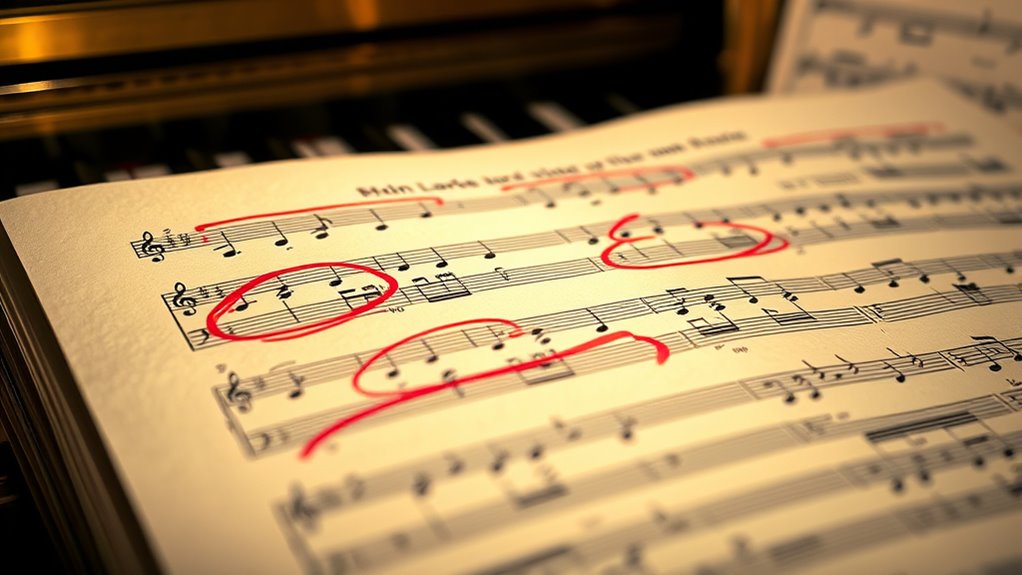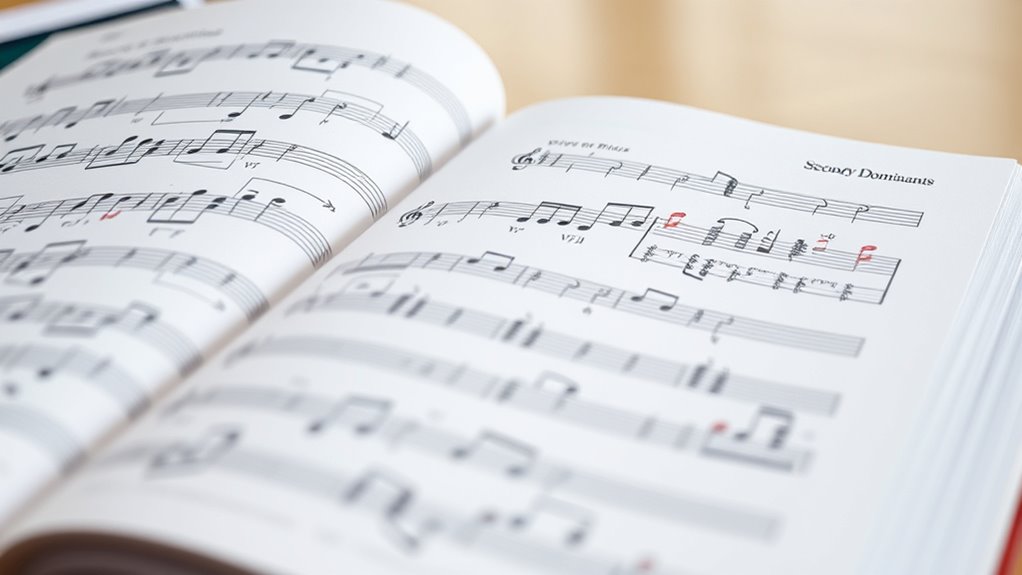Secondary dominants are your secret weapon for energizing chord progressions without changing keys. They briefly tonicize specific chords by functioning as their dominant, creating tension and a sense of drive. Using symbols like V7/V or V/ii helps you identify these moments. If you want to learn how to apply secondary dominants to add color, tension, and excitement—without modulating—you can explore more about their construction and creative uses.
Key Takeaways
- Secondary dominants temporarily tonicize non-tonic chords, creating tension and drive without changing the overall key.
- They are notated as V7/ii, V/IV, etc., highlighting their specific target chords.
- Proper voice leading ensures smooth, seamless progressions while emphasizing the target harmonic area.
- Using secondary dominants adds harmonic interest and complexity without requiring a key modulation.
- Recognizing and applying secondary dominants effectively “turbo-charges” progressions by increasing tension and resolution.
What Are Secondary Dominants and How Do They Function?

Secondary dominants are chords that temporarily tonicize a chord other than the tonic by functioning as its dominant. When you see a chord that feels like a strong pull or “drive,” it’s likely acting as a secondary dominant. These chords are usually the V of another chord within the key, creating a sense of tension that resolves when moving to the target chord. For example, in C major, a D major chord (V of G) can lead to G, even though G is the true dominant. By using secondary dominants, you add color and interest to your chord progressions. They give a sense of movement and anticipation, making your music sound more dynamic without changing keys. This technique is essential for creating smooth, engaging progressions. Understanding how secondary dominants function helps musicians craft more compelling harmonic progressions, as they can manipulate tension and resolution more effectively. Additionally, incorporating these chords can enrich your harmonic vocabulary and add sophistication to your compositions. Recognizing the role of harmonic tension helps in understanding how secondary dominants create a sense of forward motion in music.
The Musical Theory Behind Secondary Dominants

Understanding the musical theory behind secondary dominants helps you see how they create tension and movement within a progression. You’ll learn how they are constructed to target specific chords and why they’re used to add color and interest. By mastering their function and purpose, you can enhance your harmonic vocabulary and create more compelling music. Recognizing the role of the tonic in shaping harmonic direction further deepens your understanding of how secondary dominants influence musical storytelling. Additionally, understanding relationship dynamics can help musicians interpret emotional subtext and develop expressive playing. An awareness of personal growth techniques such as reflection and goal-setting can also inform your approach to practicing and mastering these concepts effectively. An awareness of website privacy policies and cookie categories can also inform how digital tools and resources are used to study and practice these concepts.
Function and Purpose
Secondary dominants serve a pivotal role in music by creating temporary tension and highlighting specific chords within a progression. They draw your focus, adding excitement and a sense of anticipation, like a musical wink. Their purpose is to emphasize certain chords, making *shift* feel more dynamic. This emotional effect keeps listeners engaged and guides their ear through the story the music tells. Consider their function as a kind of musical spotlight, intensifying moments without permanent change. Additionally, understanding their harmonic function can deepen a performer’s expressive capabilities. Recognizing how secondary dominants relate to the overall key can enhance harmonic understanding, enriching the performer’s interpretative palette. Moreover, familiarity with their theoretical basis helps composers craft more compelling and cohesive progressions. Exploring how these concepts interact with broader musical structures can further improve compositional skill, offering new avenues for creative expression.
Construction and Usage
Have you ever noticed how certain chords seem to briefly steal the spotlight in a progression? That’s often due to secondary dominants, which are built by taking the V of a chord you want to emphasize. To construct one, you identify the target chord, then find its dominant—usually a fifth above—and add a seventh if needed for tension. These chords are commonly notated with a slash or Roman numeral, like V7/ii or V/IV. You use them right before the target chord to create a sense of anticipation or drive. When used effectively, secondary dominants add color and momentum, making progressions more dynamic. Understanding tonal functions helps in recognizing how secondary dominants contribute to musical tension and release. By analyzing harmonic functions, musicians can better predict and craft effective progressions. Mastering the use of secondary dominants can significantly enhance your harmonic vocabulary and add sophistication to your compositions. Additionally, functional harmony provides a framework for understanding how these chords operate within a key.
Recognizing Secondary Dominants in Popular Songs

Recognizing secondary dominants in popular songs can substantially enhance your ability to identify key changes and harmonic tension. Pay attention to moments where a chord briefly feels like a “pivot,” creating a sense of expectation or surprise. Typically, secondary dominants appear as dominant chords—V or V7—that target a chord other than the tonic, often sounding like a “pull” or “push” toward a new harmony. Listen for chords that seem to temporarily emphasize a different note or chord within the progression. These chords often stand out due to their strong, resolved feel or because they introduce tension that resolves smoothly. By honing your ear for these signals, you’ll start noticing secondary dominants more easily, deepening your understanding of song structure and harmonic language. Additionally, recognizing antioxidant properties in certain harmonic progressions can help you appreciate how tension and release contribute to emotional expression in music, as the concept of tension and release is fundamental in music theory.
Common Symbols and Notation for Secondary Dominants

Understanding the symbols and notation used for secondary dominants is essential for analyzing harmonic progressions effectively. These symbols quickly communicate the function of a dominant chord targeting a specific scale degree. Typically, you’ll see the Roman numeral “V” with an added label indicating the target chord. For example, a secondary dominant of the V chord in the key of C would be written as V7/V, meaning a dominant seventh chord targeting the V chord (G).
- Recognize the use of Roman numerals with slash notation (e.g., V7/V, V/ii) to specify the target chord.
- Understand that the uppercase indicates a major or dominant function, while lowercase indicates minor.
- Note that numbers can specify the key or chord being targeted for clarity.
Practical Examples of Using Secondary Dominants in Progressions

Secondary dominants are powerful tools for creating tension and color in harmonic progressions. They add excitement by temporarily emphasizing a chord other than the tonic, making the music more dynamic. For example, in a C major progression, introducing a D7 before G major (V/V) highlights the upcoming dominant, building anticipation. You might play a progression like C – D7 – G, where D7 functions as V/V. Another common use is inserting an A7 before D minor, emphasizing the ii chord in C major. These chords create a sense of expectation that resolves smoothly when returning to the target chord. By incorporating secondary dominants thoughtfully, you can make simple progressions more engaging and expressive without changing keys.
Step-by-Step Guide to Incorporating Secondary Dominants

To incorporate secondary dominants smoothly, start by identifying the target chords you want to emphasize. Then, focus on applying proper voice leading to create seamless shifts. With these steps, you’ll add tension and interest to your progressions confidently.
Identifying Target Chords
When incorporating secondary dominants into your progressions, the key is to identify the target chord that the dominant will lead to. This involves recognizing which chord you want to emphasize or highlight in your progression. To do this effectively, consider the harmonic function and the natural pull of the dominant.
- Look for chords that are a fifth above the target, such as V/ii leading to ii.
- Identify chords that create tension that resolves smoothly to the chord you want to emphasize.
- Use scale degrees and key signatures to determine which chords can be temporarily reinterpreted as dominant functions.
Focusing on these clues guides you to the correct target chord, making your secondary dominants more purposeful and impactful.
Applying Proper Voice Leading
How can you guarantee that secondary dominants lead smoothly into their target chords? The key is proper voice leading. Start by moving the dominant seventh chord’s tones by step or common tone to the chord you want to emphasize. For example, if you’re moving from V7/IV to IV, ensure the seventh of the V7/IV resolves down by step to the root of IV. Avoid awkward leaps; instead, aim for smooth, connected lines. Keep the common tones intact when possible. Also, resolve dissonant tones (like the seventh of a V7) downward or upward, depending on the context. Good voice leading creates seamless transitions, making the progression sound natural and coherent. Practice this by playing through progressions slowly, focusing on smooth, logical voice movements.
Tips for Differentiating Between Modulation and Secondary Dominants

Distinguishing between modulation and secondary dominants can be challenging because both involve temporarily emphasizing a different key or chord. To tell them apart, pay attention to how the key change is introduced and sustained. Modulation usually involves a clear, deliberate shift that lasts over multiple chords, often with a pivot chord or direct modulation. Secondary dominants, however, act as quick, temporary tonicizers without fully changing the key.
Consider these tips:
- Listen for a sustained key change versus a quick tonicization.
- Notice if the new key is maintained or if it reverts quickly.
- Identify pivot chords that link the original key to the new one, typical in modulation.
Using these cues helps you identify whether you’re hearing a temporary tonicization or a true key change.
Creative Applications and Variations of Secondary Dominants

Secondary dominants are versatile tools that composers and improvisers can creatively incorporate to add color, tension, and surprise to their progressions. You can experiment with their placement to emphasize certain chords or create unexpected shifts. For example, using secondary dominants as passing chords can smooth transitions or add flair. You might also vary their qualities—turning a major dominant into a dominant seventh for extra tension or altering their voicings for unique textures. Here’s a quick overview:
| Application | Description |
|---|---|
| Passing chords | Insert secondary dominants between diatonic chords |
| Voice leading experiments | Use different inversions for smooth lines |
| Modal interchange | Combine with borrowed chords for color |
| Tension extension | Add 9ths or 13ths to intensify the dominant |
| Unexpected placements | Place secondary dominants unexpectedly for surprise |
Frequently Asked Questions
How Do Secondary Dominants Influence Emotional Tension in Music?
You might notice that secondary dominants create emotional tension by highlighting a specific chord, making it stand out as more urgent or dramatic. They add surprise and anticipation, pushing the music forward and heightening your emotional response. When you hear these chords, they intensify the harmonic landscape, making the resolution feel more satisfying. fundamentally, secondary dominants act like musical magnets, pulling your ear and emotions toward key moments.
Are Secondary Dominants Used Differently Across Musical Genres?
Imagine the thrill of a familiar tune suddenly taking a surprising turn—that’s often where secondary dominants come in. Across genres, you’ll notice they’re used differently: in classical music, they add complexity; in jazz, they create tension and release; in pop, they inject excitement. You might not always notice them, but their subtle presence keeps your ear engaged, making each progression feel fresh and emotionally charged.
Can Secondary Dominants Be Applied in Improvisation Techniques?
You can definitely apply secondary dominants in improvisation to add tension and color. They help you target specific chords, making your solos more exciting and harmonically rich. When you incorporate secondary dominants, you create moments of surprise that catch the listener’s ear. Practice recognizing these chords in progressions, and experiment with including them in your improvisations to deepen your musical expression and make your playing more dynamic.
What Are Common Mistakes When Using Secondary Dominants?
When using secondary dominants, you might often rush their resolution or overuse them, making your progressions sound forced or overly complicated. You could also forget to voice lead smoothly or choose inappropriate chords that clash with the key. To avoid these mistakes, focus on clear voice leading, use secondary dominants sparingly, and guarantee they enhance the harmony without overshadowing the main progression.
How Do Secondary Dominants Connect to Other Harmonic Devices?
Ever wondered how secondary dominants fit into your harmonic toolkit? They connect smoothly to other devices by acting as temporary tonicizers, leading to specific chords or keys. You can link them with modal interchange, borrowed chords, or altered scales, creating richer progressions. By understanding these connections, you’ll make your music more dynamic and cohesive, avoiding jarring shifts. Think of secondary dominants as versatile bridges that enhance your harmonic language effortlessly.
Conclusion
Now that you see how secondary dominants turbo-charge your progressions, you’ll notice them everywhere—even when you least expect it. As you experiment, you might find a surprising connection between a chord you thought was simple and a whole new emotional depth. Keep listening and playing; these tiny tricks can uncover endless creative possibilities. Sometimes, the most subtle harmonic touches create the most memorable moments—just like a secret ingredient waiting to be discovered.









